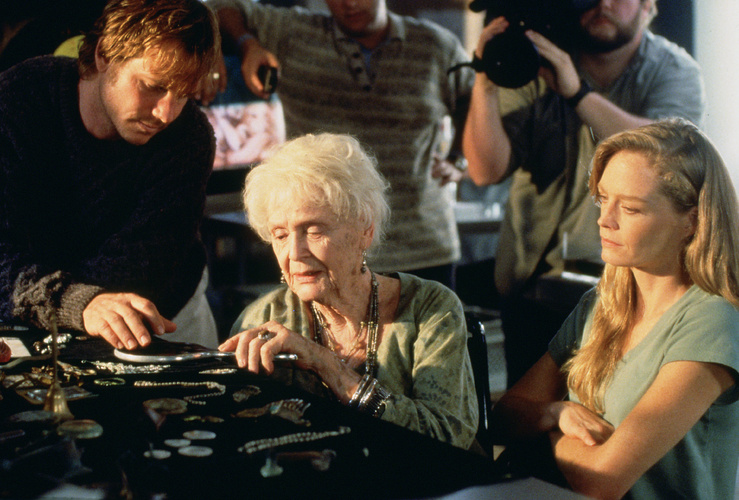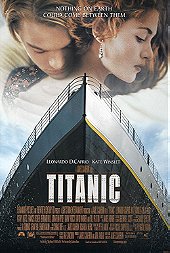With a budget reportedly exceeding $200 million, James Cameron's Titanic was the most expensive motion picture in history upon its release in 1997. During production, the cards were heavily stacked against the movie; it starred commercially unproven actors, online commentators derided the story as a Romeo and Juliet rip-off, and costs continued to climb, forcing a nervous Twentieth Century Fox to sell the domestic distribution rights to Paramount Pictures. Yet, nothing but phenomenal success welcomed Titanic - it eclipsed expectations, dominated the Academy Awards by winning eleven categories, and earned a whopping $1.8 billion at the worldwide box office, making it the highest-grossing film of all time until Cameron's follow-up project, Avatar, dethroned it. Grand in scope and emotion, Titanic proves that epic sagas in the tradition of Lawrence of Arabia and Ben-Hur are not a thing of the past and can still be successful and profitable, especially when in the hands of passionate and talented filmmakers.

In April 1912, the "unsinkable" R.M.S. Titanic struck an iceberg and sank in the Atlantic Ocean during its maiden voyage, claiming the lives of 1,500 people. Titanic does not open in 1912, however - it begins in the late 1990s, during a salvage expedition to recover a priceless diamond known as the Heart of the Ocean, which may have gone down with the famous ocean liner. When the team recovers a drawing from the wreck of a young woman wearing the Heart of the Ocean, the discovery catches the eye of 100-year-old Rose Calvert (Gloria Stuart), who claims to be the woman in the artwork. On a visit to the research ship in the Atlantic Ocean, treasure hunter Brock Lovett (Bill Paxton) draws Rose into telling her account of the Titanic's ill-fated maiden voyage. Engaged to wealthy millionaire Caledon Hockley (Billy Zane), the youthful Rose DeWitt Bukater (now played by Kate Winslet) boarded the Titanic, utterly bored with the life that her mother (Frances Fisher) forced her into. While contemplating suicide in a moment of desperation, Rose meets third-class passenger Jack Dawson (Leonardo DiCaprio), who compels her to reconsider. In the following days, a romance begins to form between them, but the class separation is a significant obstacle. Additionally, further peril emerges when the Titanic strikes an iceberg and begins to flood rapidly.
Short of discovering time travel, James Cameron's Titanic is the closest that any film-goer will get to exploring the Titanic's decks. The recreations of the ship's interiors burst with authenticity, as nothing feels like a mere set due to the attention to detail, including accurate dinner plates and silverware that feature the White Star Line emblem. The picture's production designer, Peter Lamont (a Bond regular), consulted the ship's original blueprints, and the production even used the manufacturer of the Titanic's original carpet. In each of his previous movies, the hands-on Cameron has continued to push the special effects envelope in groundbreaking and inspiring ways. Each film for Cameron is not just another day at the office but another revolutionary breakthrough for cinema, and Titanic continues this tradition.
From bow to stern, the unsinkable Titanic comes alive in breathtaking and awe-inspiring ways, blurring the line between what's real and what's digital through a seamless combination of enormous sets, model work, and borderline flawless computer-generated imagery. Aside from a few dated computer-generated passengers in certain shots, viewers will seldom be consciously aware that digital effects are on the screen, which is a tremendous feat for a late-'90s production. It is impossible to overstate how flawless the recreation of the ship truly is, and Cameron never ruins the illusion - it always feels like the real Titanic, not a massive set or a miniature. Cameron even uses genuine footage of the Titanic wreck lying on the bottom of the North Atlantic Ocean, contributing to the production's sense of verisimilitude. Additionally, Cameron and cinematographer Russell Carpenter, whose efforts earned an Academy Award, use Ken Marschall's paintings as a visual influence for several striking shots of the ship.
Many online commentators understandably chortled at the prospect of a $200 million feature film with a foregone ending. However, Cameron's movie is about far more than the sinking of an ocean liner in the Atlantic Ocean. While the film does cover the disaster in appreciable detail, Titanic is primarily a love story. Most blockbuster directors like Michael Bay prefer to use a thin story as an excuse for mindless special effects self-indulgence, but Cameron uses special effects to serve his storytelling. Cameron also has a knack for generating emotional power amidst the spectacle, and Titanic reinforces this, as it is challenging not to be genuinely invested in Jack and Rose's relationship by the time the iceberg appears. Given that 2,200 souls were on board the Titanic as she sank, it would have been easy to cram the film with lots of characters within lots of stories. However, Cameron keeps the story of Jack and Rose at the fore, and the camera only occasionally leaves their side for scenes of historical clarification. The director knows when to dial back the scope to focus on intimate character moments, from the scene where Jack sketches Rose in her stateroom to the heartbreaking moment when a freezing Jack convinces Rose that she will survive the disaster, despite the disconcerting odds.
As the grand ship sinks into the ocean, Cameron crafts some of the most impactful and emotionally devastating images of his career. Despite the rising water levels, Titanic's band continues to play on her decks, and the band's final tune - "Nearer, My God, to Thee" - gives way to a heart-wrenching montage. Also heartbreaking are the images of the harsh ocean obliterating this beautiful ship, such as the flooding of the Grand Staircase and the breaking of the luxurious dome. Whereas previous Titanic films seemingly show the ship gracefully sliding underwater, Titanic is the first cinematic portrayal of the disaster to emphasise the violence, terror, and chaos of the sinking, with the ship splitting in half and a terrifying final plunge in almost complete darkness. Most affecting of all, though, are the shots of hundreds of people thrashing around in the freezing sea, giving way to a field of floating, frozen corpses. Perfectly accompanying the astonishing visuals is James Horner's Oscar-winning score. This epic tale required an epic score, and Horner was up to the task, providing intimate music for the quieter scenes, grandiose music to match the sweeping imagery, pulse-pounding music to amplify the sinking's intensity, and emotionally affecting music to underscore the tragedy of the fateful night. Anyone who watches this movie without getting a tear in their eye is a stronger man than this reviewer.
Critics often deride Titanic for not focusing enough on historical detail. Admittedly, there are a few inaccuracies (the collapsible boats are inaccurate here, for instance), while the film omits the stories of both the Californian (a ship in eyesight of the Titanic as she sank) and the Carpathia (a liner which answered the Titanic's distress call but did not arrive in time). But the aim of Cameron's movie was not to provide the definitive retelling of the disaster, but to tell an account of the Titanic's sinking from a specific vantage point. The camera never leaves the decks of the doomed ocean liner as she sinks, which is beneficial for both pacing and building intoxicating tension. Titanic is an exciting and compelling disaster movie, maintaining a robust pace as panic builds and the ship's fate becomes clearer to her passengers. Once the water reaches the boat deck, the last stages of the sinking occur in real time as Titanic's officers desperately try to launch the collapsible boats, the funnels fall, and passengers flee to the stern. Cameron called upon several experts to serve as consultants on the project, including Titanic historians Don Lynch and the aforementioned Ken Marschall.
In the lead roles, Leonardo DiCaprio and the Oscar-winning Kate Winslet are both flawless. As Jack Dawson, DiCaprio is likable, energetic, and passionate - vital characteristics for bringing the part to life. Meanwhile, Winslet, who espouses a believable American accent, is stunning as Rose - the actress always appears focused and committed to the material, and she looks wonderful in period costumes. Alongside this pair is Billy Zane, who plays a convincing villain - snobby, arrogant and dislikeable. Joining him is the equally commendable David Warner, who was in the 1970s miniseries S.O.S. Titanic, as his no-nonsense manservant. The supporting cast, many of whom play historical characters, is excellent from top to bottom. Notable performances include Bernard Hill as Captain E.J. Smith and Walter Garber, who makes for a convincing and likable Thomas Andrews with a convincing Irish accent. Also worth mentioning is Kathy Bates, whose performance as "The Unsinkable Molly Brown" never strikes a false note, and Jonathan Hyde, who paints a wonderfully conceited portrait of Bruce Ismay.
Although Titanic runs a gargantuan 195 minutes, Cameron bestows the picture with a storytelling economy and an astonishing sense of pace. Even the most critically acclaimed cinematic epics in history, from Lawrence of Arabia to The Bridge on the River Kwai, have their drab moments, but not a single frame of Titanic feels inessential or tedious. Unfortunately, Titanic still receives a lot of criticism and is often belittled as a cheesy chick flick. The hate is entirely unfounded and unfair, as this is an excellent motion picture that deserves its success and acclaim. However, despite its strengths, the film is not perfect. There are illogicalities (Rose knows of Sigmund Freud's work, yet it was not translated into English until several years after the disaster) and some blatant technical faults (apparently, this is the most goof-ridden film of all time). As a Titanic enthusiast, I also wish the film were longer, but that's a matter of personal preference.
In 2012, the film received a 3D makeover for a theatrical re-release to commemorate the centenary of the Titanic disaster. Cameron (ever the perfectionist) and his crew reportedly spent 60 weeks painstakingly converting the picture to 3D, frame by frame, and the results breathe extraordinary new life into the film. The 3D conversion is arguably the most impressive to date, as it genuinely looks like Cameron shot the film natively in 3D. Furthermore, the third dimension is not just a gimmick since it enhances the film. The decks and hallways of the ship look longer and vaster (it is terrifying to watch Rose frantically navigating the labyrinthine hallways below deck as the ship sinks), and it seems like the ship is right there in front of us through a window. The 3D format allows you to absorb the countless layers of visual information, enabling you to detect intricate details you may have never noticed before. Indeed, the Titanic comes alive like never before, and the scenes of its demise are even more breathtaking than they were back in 1997. You cannot afford to miss the 3D experience.
A disappointing ending could have sunk Titanic, and the odds were against Cameron in this regard. After all, how could the filmmaker possibly give satisfying closure to the story of a tragic disaster wrapped around such an affecting romance fable? Fortunately, the proceedings conclude with a beautiful, emotionally resonant scene that does the film justice and resonates with the events of the past three hours. James Cameron's Titanic is a dazzling work of cinematic art that mixes style and substance with staggering confidence. It runs for a daunting three hours, yet the time flies by with immaculate brevity. Most may not regard this as the best cinematic portrayal of the Titanic disaster, but it's inarguably the most memorable and spectacular, with its tremendous emotional power, compelling human drama, and groundbreaking special effects.
9.0/10
 Login
Login



